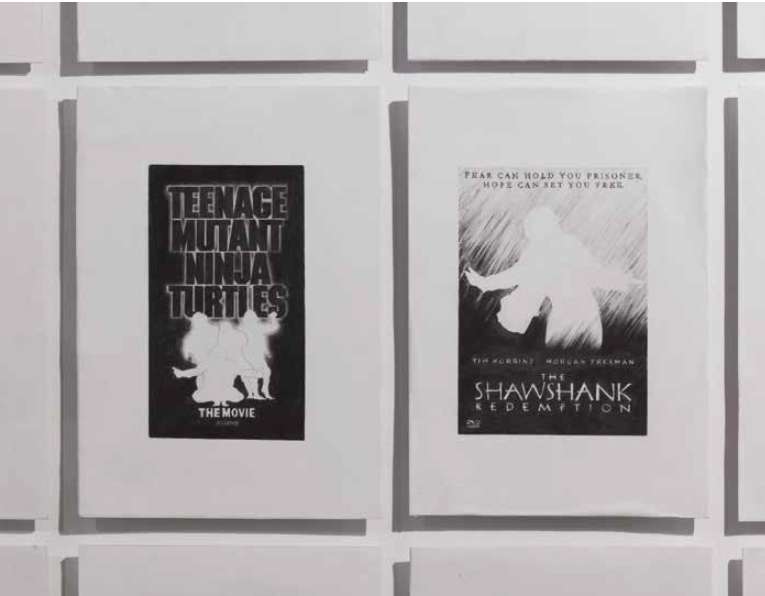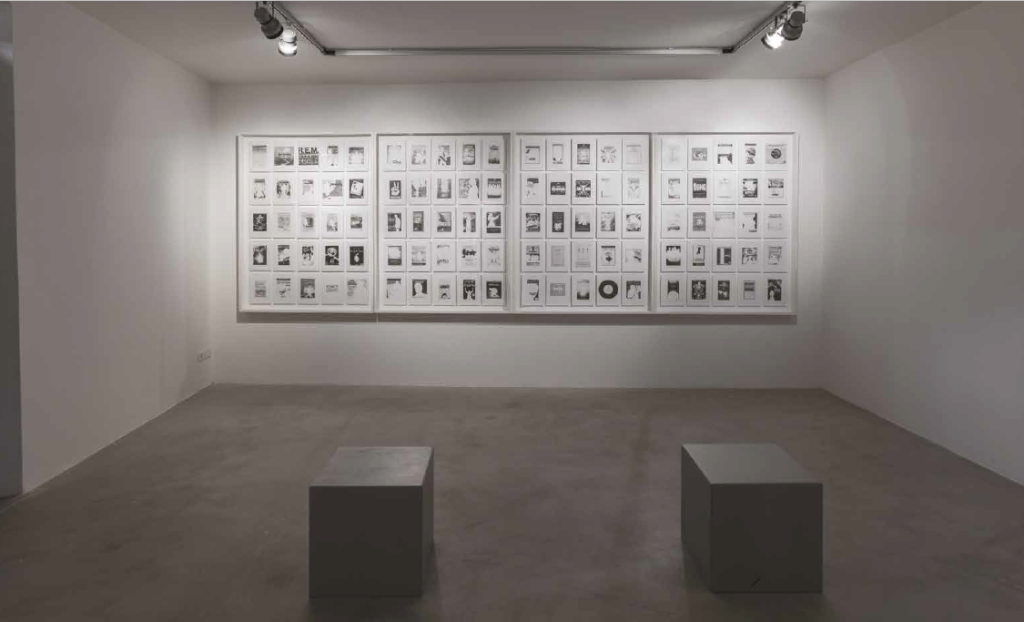[English text below]
Le quattro stanze oltre la passerella sono dedicate allo svelamento dei processi che hanno portato alla realizzazione di I Am Not Legend proiettato al primo piano. La realizzazione di un film animato richiede l’esecuzione manuale di ogni singolo frame, in questo caso estratto dal film originale, selezionato, stampato e filtrato da alcuni interventi pittorici legati alle necessità di senso che l’artista ha voluto imprimere alla trama, oltre che alla sistematica cancellazione degli zombie con l’acrilico bianco. Un piccolo assaggio delle tavole usate per il film, 185 su 100.000, sono proposte in mostra regimentate da cornici regolari, dando vita a un concerto ordinato e corale, capace di raccontare il processo e sintetizzare egregiamente lo sviluppo narrativo del film.
Ma è grazie all’ultima opera realizzata dall’artista, presentata nella stanza finale, che si chiude il cerchio. In ordine di apparizione è un moderno polittico in quattro cornici identiche che presentano, ciascuna, 25 disegni a grafite. Conclusa dall’artista a pochi giorni dall’inaugurazione, dopo due mesi di lavoro senza sosta, l’opera è una sorta di omaggio postumo al film o, meglio, è lo svelamento finale delle fonti cui Mastrovito ha attinto per comporne i dialoghi e intessere il suo intreccio narrativo. L’artista ha ridisegnato le copertine di 100 titoli, tra album, libri e film, nei quali non è difficile rintracciare le predilezioni di un ragazzo cresciuto negli anni Ottanta e Novanta, deciso ad attingere a tutti i registri della commedia e della tragedia, senza snobismi: si parte con Se questo è un uomo di Primo Levi, si passa per l’Amleto di Shakespeare o 1984 di George Orwell, attraversando le canzoni dei Metallica, dei Doors e dei R.E.M., o film generazionali come La storia infinita, Platoon, Terminator, Blade Runner e Matrix. Torna lo strumento principe di conoscenza e riappropriazione di Mastrovito, il disegno, e torna quel fermarsi sulla soglia dell’indefinibile. Quel bianco che ci preclude la vista del personaggio principale di ogni copertina è ottenuto fermando la matita, non disegnandolo, dando vita a un moderno non-finito, con cui l’artista, per ora, si trattiene sulla soglia.
“A quattro anni dipingevo come Raffaello, poi ho impiegato una vita per imparare a dipingere come un bambino”. È la celebre frase che si attribuisce a Picasso e che ci ronza nel cervello da qualche tempo, pensando al lavoro di Mastrovito e cercando d’immaginare dove ci porterà. Che ne sarà di questo processo di appropriazione del reale che è atto d’amore? Se arriveranno anche per lui i giorni della sintesi, a tempo debito s’intende, ci godremo anche quelli. Per ora, in questo fiume inesausto della creatività contemporanea, sempre in lotta con il limite proprio e della materia, converrà prepararsi al prossimo episodio d’appropriazione e restituzione poetica.
In order of appearance
The four rooms beyond the walkway are given over to the unveiling of the processes which
led to the creation of I Am Not Legend screened on the first floor. The creation of an animated film calls for the manual processing of every single frame, in this case extracted from the original film, selected, printed, and filtered by a number of pictorial interventions linked to the necessities of meaning that the artist decided to impress upon the plot, along with the systematic blotting out of the zombies with white acrylic paint. A little taste of the images used for the film, one hundred and eighty-five of them out of one hundred thousand, are featured in the show, complete with normal picture frames, giving rise to an orderly and choral concert, one capable of narrating the process and skilfully summing up the narrative development of the film.
But it is thanks to the latest work produced by the artist, presented in the final room, that
the circle comes to a close. In ordine di apparizione is a modern polyptych in four identical picture frames which each feature twenty-five graphite drawings. Completed by the artist only a few days prior to the opening, after two months of tireless toil, the work is a sort of posthumous homage to the film, or rather, it’s the final unveiling of the sources that Mastrovito drew on in order to put together its dialogues and weave its narrative fabric. The artist redesigned the front covers of a hundred publications, including albums, books and films, in which it is not hard to retrace the predilections of a boy who grew up in the 1980s and ’90s, with the idea of “drawing on all the registers, from comedy to tragedy, without snobbism: we start out from If this is a Man by Primo Levi, via Shakespeare’s Hamlet or George Orwell’s 1984, through to the songs of Metallica, the Doors and REM, or generation-defining films such as the Never-Ending Story, Platoon, Terminator, Blade Runner and Matrix. Mastrovito’s favourite means of knowledge and reappropriation
returns – drawing – as does his pausing on the verge of the undefinable. That white which stops us from seeing the main figure on the front of every magazine cover is obtained by halting the pencil, drawing no further on the cover, giving rise to a modern non-finite, of which the artist, for now, remains on the threshold.
“In four years I learnt to paint like Raphael, but it took me a lifetime to paint like a child.”
this is the famous quote attributed to Picasso and which has been buzzing around our head for some time, thinking of the work of Mastrovito and trying to imagine where it might lead us. What will be of this process of appropriation of reality which is an act of love? If he too one day enters the realm of synthesis, in all due time, of course, we shall enjoy that as well. But for now, in this gushing torrent of contemporary creativity, always struggling against its own limitations and that of the materials, it might be a good idea to get ready now for the next installment of poetic appropriation and restitution.

